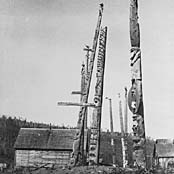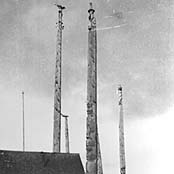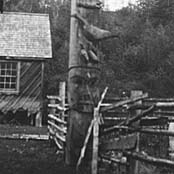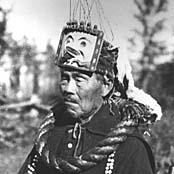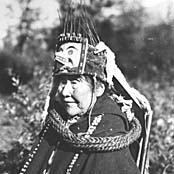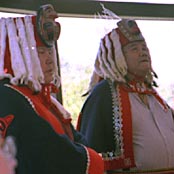Grand Hall tour
 |
History of the Pole |
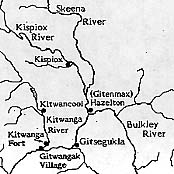
|
|
Map of the Gitksan villages of the Skeena and Nass Rivers From The Totem Poles and Monuments of Gitwangak Village by George MacDonald, 1984 |
The totem pole Gambalch was carved in 1876 by William Brown (Kwodzabax) and erected in the Tsimshian village of Gitsegukla on the upper Skeena river (see map) by Thomas Campbell (Alimlaxe) and his brothers from the family of Ksrarom-larhae in the House of Gim-sta-lox ("House-of-the-inside-the-half-Sun"). Skugumlahaxe is the Head Chief of the Gim-sta-lox. Since there are two groups in one House, the other group is under Niis Noolth. Some House groups may have three divisions, but only one head, hereditary Chief to oversee the group.
The pole was first photographed in 1910 by George T. Emmons for the Museum of the American Indian. It was recorded in a painting entitled Totem Poles, Kitseukla by Emily Carr in 1912 (now owned by the Vancouver Art Gallery).
In 1925 Marius Barbeau of the Museum Branch of the Department of Mines photographed and documented the pole. By 1952 when it was again photographed, by Professor Wilson Duff of the University of British Columbia, the pole, which had stood upright in the village for about 65 years, had been lying on the ground for about 10 years. In 1967 three sections of the pole were acquired by art dealer W. Helmer and were stored by him in Vancouver for the next 22 years.
|
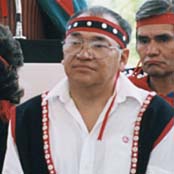
|
|
Master Carver Sam Wesley Photograph: Chris Payne |
In 1989 the Canadian Museum of Civilization acquired those three surviving sections of the pole from Helmer, thanks to a contribution from the Government of Canada under the terms of the Cultural Properties Export and Import Act. In 1997 an agreement between the Museum and the Hereditary House Chiefs Ray Jones (Niis Noolth) and Vernon Milton (Skugumlahaxe) led to the restoration of the three original sections by the Museum and the recarving of the four missing sections of the pole by master carver Sam Wesley of Gitsegukla. The pole was erected in the Museum on March 30, 1998 and re-dedicated on May 17.
The original carver was William Nass or Brown (Kwodzabax) of the house of Taku of Gitwanga. Brown belonged to the Tsimshian counterpart of the Fireweed phratry (the Gispwudwade). This makes him a phratric relative, which is contrary to a universal custom of having the carver from outside the phratry (kinship group). Some arrangement may have been made to address this problem: normally a nominal carver outside the phratry is identified to oversee the work.
